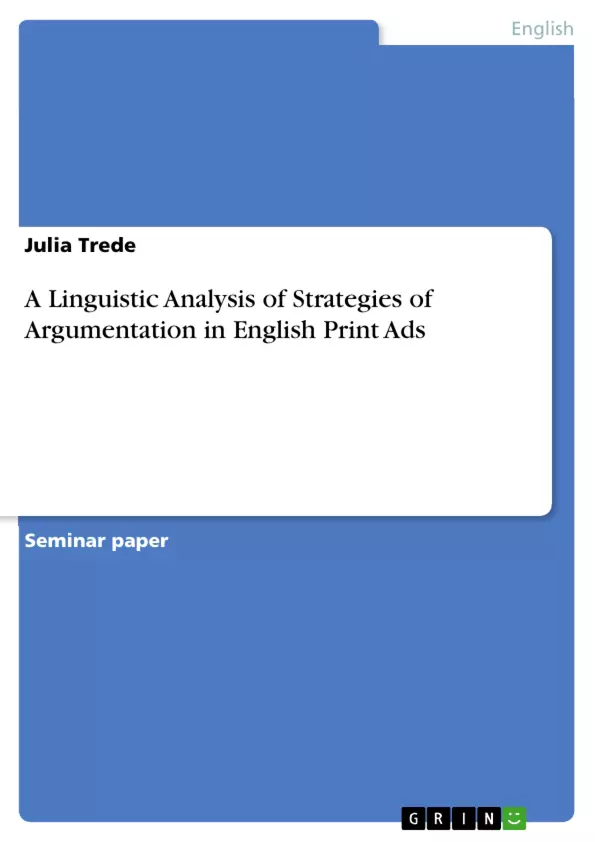No matter where we are advertisements are everywhere, but how do people decide which product to buy? Today consumers may choose which toothpaste or shampoo they want to purchase because there is a huge range of brands that offer the same goods, therefore companies have to persuade consumers to buy their product. As a student of linguistics I asked myself how argumentative persuasion in advertising functions and how it contributes to its effectiveness. I found two very interesting approaches by Clemens Ottmers and Nina Janich who determined different argumentation strategies for analysing advertisements.
Although there is a lot of literature dealing with language and advertising, there are only few works concerned with strategies of argumentation in advertising. Since 1945, and especially during the economic miracle, there has been a steady increase of research in the field of language and advertising. First works dealing with argumentation and advertising were published in the 1960s. In the course of years linguists concentrated more on specific linguistic aspects of advertising and presented first analysing methods. Furthermore, they focused on rhetoric figures, strategies of advertising, and on the effects of images. Nowadays, linguistic research concentrates on semiotics and image-text-relations, as well as on intentions, persuasion in advertisements, and TV spots. However, the main problem of linguistic research of advertising is the lack of a fundamental work dealing with language of advertising and its versatility with reference to images and advertising media.
Inhaltsverzeichnis (Table of Contents)
- Introduction
- Argumentation Theories
- Formal Argumentation Strategies (Ottmers)
- Enthymematic Argumentation
- Argumentation Through Exemplification
- Inductive Example
- Illustrative Example
- Topoi
- Topoi based on everyday-logic generic premises
- Topoi with conventionalised conclusions
- Content Based Strategies (Janich)
- Reference to Product
- Reference to Sender
- Reference to Recipient
- Formal Argumentation Strategies (Ottmers)
- Analyses of Strategies of Argumentation in Print Ads
- Method of Analysing
- Analyses
- Print Ad 1: Olay Professional Pro-X Clear
- Print Ad 2: Garnier Fructis Pure Clean
- Print Ad 3: L’Oréal Ever Sleek
Zielsetzung und Themenschwerpunkte (Objectives and Key Themes)
The main objective of this research paper is to demonstrate that Ottmers’ Formal Strategies of Argumentation and Janich’s “Content Based Strategies of Argumentation” provide a comprehensive theoretical basis for analyzing strategies of argumentation in advertisements. The key themes of this research paper are: * Formal Argumentation Strategies (Enthymematic and Exemplary Argumentation) * Content Based Strategies of Argumentation (Reference to Product, Sender, and Recipient) * Topoi in Argumentation * Analysis of strategies of argumentation in print adsZusammenfassung der Kapitel (Chapter Summaries)
The "Introduction" chapter sets the stage for the research paper by discussing the prevalence of advertisements in modern society and the importance of understanding argumentation strategies in persuasion. It also provides a brief overview of existing literature on language and advertising, highlighting the lack of a comprehensive work that deals with the language of advertising and its versatility in relation to images and advertising media. The "Argumentation Theories" chapter provides a theoretical framework for the analysis of argumentation in advertisements. It begins by presenting Ottmers' approach to formal argumentation strategies, which categorizes strategies as enthymematic argumentation, exemplary argumentation (including inductive and illustrative examples), and Topoi. The chapter then delves into Janich's concept of content-based strategies, which include reference to the product, the sender, and the recipient. The "Analyses of Strategies of Argumentation in Print Ads" chapter applies the theoretical framework to the practical analysis of three print ads. The chapter first outlines the method of analysis, which involves dividing each print ad into its components (headline, text body, and slogan) and then identifying the formal and content-based strategies employed. It then presents a detailed analysis of each print ad, examining how each element utilizes different argumentation strategies.Schlüsselwörter (Keywords)
The primary focus of this work is on argumentation in advertising. The main keywords and concepts covered in the text include: argumentation strategies, enthymeme, exemplification, Topoi, content-based strategies, reference to product, sender, and recipient, print ads, analysis, and advertising persuasion. The paper focuses on the theoretical frameworks of Ottmers and Janich and applies their approaches to a real-world analysis of print advertisements.- Quote paper
- Julia Trede (Author), 2012, A Linguistic Analysis of Strategies of Argumentation in English Print Ads, Munich, GRIN Verlag, https://www.grin.com/document/194130



